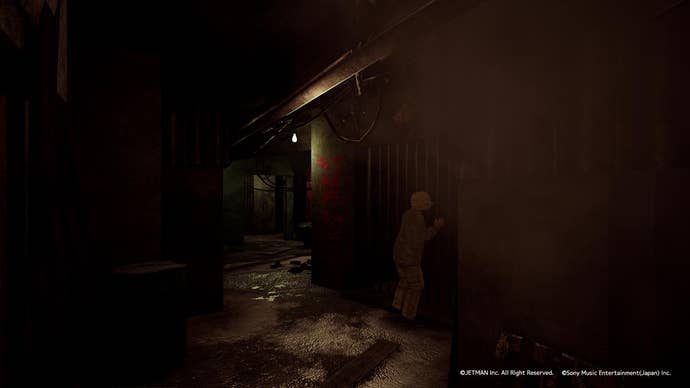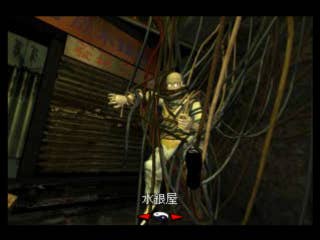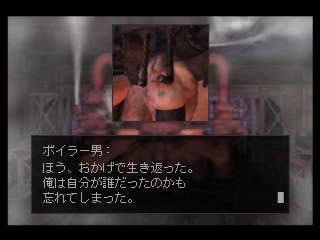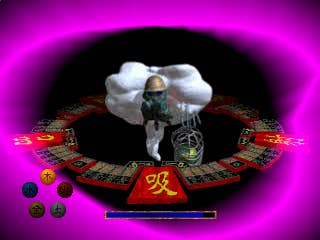A New VR Experience Reignites Forgotten Cult Classic Kowloon's Gate
For Kowloon's Gate's 20th anniversary, we reminisce about the mysterious, never-localized PS1 game.
This article first appeared on USgamer, a partner publication of VG247. Some content, such as this article, has been migrated to VG247 for posterity after USgamer's closure - but it has not been edited or further vetted by the VG247 team.
You've seen the outline of Kowloon Walled City, whether you actually know of the literal city or not. You've seen its cramped, secluded walls in the towers Judge Dredd. You've seen its densely populated apartment-like structures in a wealth of science fiction—even inspiring cyberpunk godfather William Gibson's Bridge trilogy of novels. Kowloon's everywhere.
Even when Kowloon Walled City still stood before it was demolished in 1993—a secluded, thickly populated city within Hong Kong—Kowloon had a looming presence. It was an area seemingly abandoned by both Britain and China (at this time, Britain was still occupying Hong Kong). From the outside, it looked like a bunch of apartment complexes stacked on top of one another. It was the sort of environment that was so crowded with people that it formed its own rules, its own governorship, its own tight knit community. Its existence became controversial to the outside world, ignored by Hong Kong's safety and health regulations.
Long after we'd seen it and read about it, video games gave us a fictionalized Kowloon to wander around. A Kowloon to interact with. A Kowloon to live in, like the 50,000 people who once did in its compact 6.4 acres.

Shenmue 2 is the most widely known interactive example of Kowloon Walled City in video games. The game picks up where the first Shenmue left off: with Ryo Hazuki getting off a boat to China, in search of the man who killed his father. But Shenmue 2 is hardly the only game to take players to Kowloon. Another game, a cult classic game from Japan, ventured into the territory too.
That game was Kowloon's Gate, a 1997 title for the original PlayStation. Kowloon's Gate was a mystical reimagining of the predominantly Chinese city. It was a notable video game for its time where for once the game brought its cyberpunk influences home to the very city that largely inspired the subgenre in the first place. It showed a Hong Kong at odds with two cultures, with its past and present wrestling inside of it.
It was one of many games of the original PlayStation era that played with experimentation, most of which hailed from Japanese developers. Masaya Matsuura's Vib-Ribbon revitalized vector visuals, and allowed players to pop-in any CD in their collection to be shuffled into a makeshift rhythm game. Osamu Sato's LSD: Dream Emulator brought surreal, improbable dreams to life.
Kowloon's Gate, much like those, was both visually and mechanically unique for its time. It was mostly an adventure game, with a few weird tweaks. Even artistically today it holds up, if you can bear the low resolution. Its spirits are still haunting; its NPCs stick out as memorably designed characters. While Kowloon's Gate never quite ventures into horror territory, it tiptoes into the genre just enough to unsettle players. In Japan it's developed an avid following too, even as decades have passed. In a 2009 Famitsu poll, it ranked as number 10 out of 50 in most desired sequels.




This year marks the 20th anniversary of Kowloon's Gate. For the occasion, the original's developers under the new marquee Jetman have created a sorta-sequel, sorta-love letter to the original game called Kowloon's Gate VR: Suzaku. The experience was crowdfunded last year on the Japanese Kickstarter-like site Campfire. The virtual reality-tied title for PlayStation VR released on Japan's PlayStation Store in early November for 4,298 yen (approximately $38.53). For its new VR experience, players are taken back to Kowloon from a refreshed perspective—their own. They walk around the environment, meeting familiar and new characters all around. They take photos of them, experiencing the mostly unseen phenomena again. Like the original, Kowloon's Gate VR has yet to be localized in English. I doubt it ever will.
That's part of the mystique surrounding Kowloon's Gate. It's a game only able to experienced and understood by those fluent in Japanese. I've watched Let's Plays of it, read everything I can find about the game, and still, importing would be useless for me. While visually I can digest it, in terms of its words and stories, I'm left to summaries and long-desolate fan forums.
Like the game beyond Japan, Kowloon Walled City was also mythical to those who did not live within it. In 1987, its demolition was announced—a joint venture with both British and Chinese governments. In that same year, writer Elizabeth Sinn wrote about its origins and early history for the academic journal Journal of the Hong Kong Branch of the Royal Asiatic Society. At the entry's start, Sinn frames a Kowloon Walled City that at once enamored and frightened outsiders. "Hardly a day passes now without some group of visitors trooping down the alleys hoping to see this unique physical, legal, historical and social edifice before it is gone forever," she writes. "In a way, the City remains an enigma."

This is heavily contrasted to Kowloon before the announcement of its demolition, which took many years to actually happen due to the murkiness of legal evictions. Kowloon had a reputation for being a pool for crime. Criminals "hid out" there. Drugs and prostitution had an alleged large presence in the city. Food suppliers and businesses were able to operate without the overseeing of government and sanitary regulations. People in the medical field, from dentists to doctors, who couldn't register with the Hong Kong government found a career and livelihood in Kowloon. As Sinn posits, Kowloon "was a world unto its own." Until it wasn't anymore, many years after Sinn's piece was published back in 1987.
After being demolished, landmarks were erected in Kowloon's honor. Kowloon is now a park. The city itself is no longer there. What made it notable has been erased from existence. Some structures still stand tall, but now they're polished and clean, with zero sense of community. Again, Kowloon as a city was plainly erased from existence.
Kowloon's Gate resurrects it. The game takes place in then-modern day Hong Kong in 1997, long after Kowloon has been demolished. Then one day in the game the city mysteriously arises from the rubble. Kowloon Walled City has returned, like a spirit with unfinished business. The nameless protagonist is sent to investigate how and why this happened, and to put a stop to it. The player navigates the close quarters of the newly revived Kowloon Walled City, defeating evil spirits that loom in areas to attain the four mysterious symbols and restore Yin and Yang, or peaceful balance, to the world. It's not all doom and gloom and over-exoticizing though. The player meets the city's more peaceful inhabitants too, including arguably the true hero of the game, Kowloon resident Xaohei.
That's the essence of Kowloon's Gate: exploring a culture that was once erased, only to see it restored and troublingly enable it to crumble again. Inside the walls of the mystical version of Kowloon in Kowloon's Gate is one threaded by a tight-knit community, and threatened by a hardly-seen nefarious evil. The game, as a whole, works as an allegory to real-life Kowloon.
Kowloon was seen by the outside world (namely by Britain and China) as dirty, crime-ridden, and dangerous; hardly an upstanding city by their standards. But on the inside was a city of people that found solace in each other, as seen in the work of Canadian photographer Greg Girard, who photographed life in the city for many years (which can be seen in the photobook City of Darkness). They escaped the claustrophobia of the close buildings on rooftops. And because they had no reliable government, they instead had to rely on each other; it was their only option. Kowloon was a vast, self-sufficient community first and foremost, even as history tends to forget that. And with the everlasting legacy of Kowloon's Gate and its new VR continuation, the community gets renewed appreciation. Hopefully never again to be forgotten.


